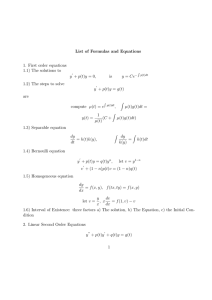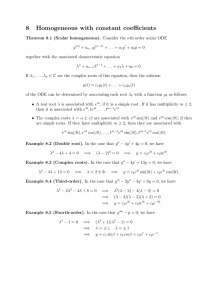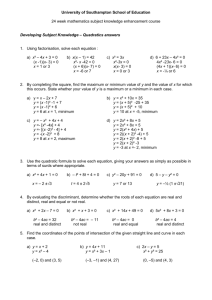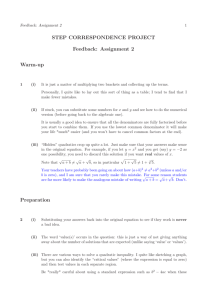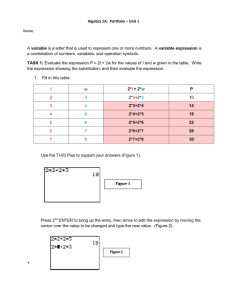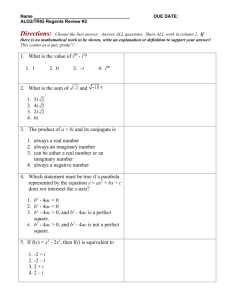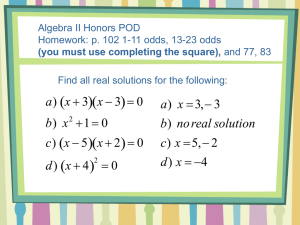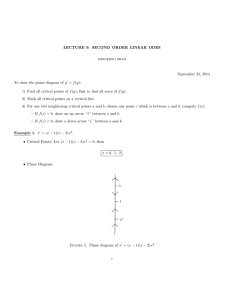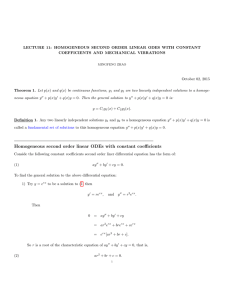Math 308 Section-Zhou, Review for Exam 1 1. 2.
advertisement
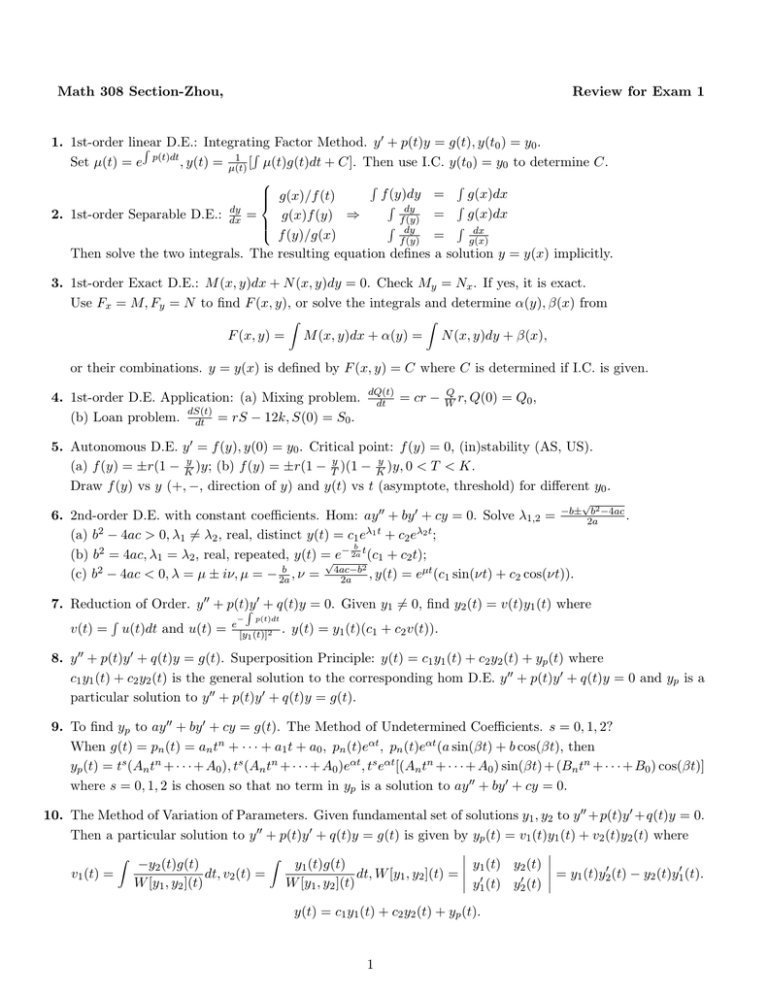
Math 308 Section-Zhou, Review for Exam 1 1. 1st-order linear Factor Method. y ′ + p(t)y = g(t), y(t0 ) = y0 . ∫ D.E.: Integrating ∫ p(t)dt 1 Set µ(t) = e , y(t) = µ(t) [ µ(t)g(t)dt + C]. Then use I.C. y(t0 ) = y0 to determine C. 2. 1st-order Separable D.E.: dy dx g(x)/f (t) = ∫ g(x)f (y) ⇒ f (y)/g(x) ∫ f (y)dy = g(x)dx ∫ dy ∫ g(x)dx f (y) = ∫ ∫ dy f (y) dx = g(x) Then solve the two integrals. The resulting equation defines a solution y = y(x) implicitly. 3. 1st-order Exact D.E.: M (x, y)dx + N (x, y)dy = 0. Check My = Nx . If yes, it is exact. Use Fx = M, Fy = N to find F (x, y), or solve the integrals and determine α(y), β(x) from ∫ F (x, y) = ∫ M (x, y)dx + α(y) = N (x, y)dy + β(x), or their combinations. y = y(x) is defined by F (x, y) = C where C is determined if I.C. is given. 4. 1st-order D.E. Application: (a) Mixing problem. (b) Loan problem. dS(t) dt = rS − 12k, S(0) = S0 . dQ(t) dt = cr − Q W r, Q(0) = Q0 , 5. Autonomous D.E. y ′ = f (y), y(0) = y0 . Critical point: f (y) = 0, (in)stability (AS, US). y y (a) f (y) = ±r(1 − K )y; (b) f (y) = ±r(1 − Ty )(1 − K )y, 0 < T < K. Draw f (y) vs y (+, −, direction of y) and y(t) vs t (asymptote, threshold) for different y0 . 6. 2nd-order D.E. with constant coefficients. Hom: ay ′′ + by ′ + cy = 0. Solve λ1,2 = −b± (a) b2 − 4ac > 0, λ1 ̸= λ2 , real, distinct y(t) = c1 eλ1 t + c2 eλ2 t ; b (b) b2 = 4ac, λ1 = λ2 , real, repeated, y(t) =√ e− 2a t (c1 + c2 t); 2 b (c) b2 − 4ac < 0, λ = µ ± iν, µ = − 2a , ν = 4ac−b , y(t) = eµt (c1 sin(νt) + c2 cos(νt)). 2a √ b2 −4ac . 2a ′ 7. Reduction of Order. y ′′ + p(t)y ∫ + q(t)y = 0. Given y1 ̸= 0, find y2 (t) = v(t)y1 (t) where v(t) = ∫ u(t)dt and u(t) = e − p(t)dt [y1 (t)]2 . y(t) = y1 (t)(c1 + c2 v(t)). 8. y ′′ + p(t)y ′ + q(t)y = g(t). Superposition Principle: y(t) = c1 y1 (t) + c2 y2 (t) + yp (t) where c1 y1 (t) + c2 y2 (t) is the general solution to the corresponding hom D.E. y ′′ + p(t)y ′ + q(t)y = 0 and yp is a particular solution to y ′′ + p(t)y ′ + q(t)y = g(t). 9. To find yp to ay ′′ + by ′ + cy = g(t). The Method of Undetermined Coefficients. s = 0, 1, 2? When g(t) = pn (t) = an tn + · · · + a1 t + a0 , pn (t)eαt , pn (t)eαt (a sin(βt) + b cos(βt), then yp (t) = ts (An tn + · · · + A0 ), ts (An tn + · · · + A0 )eαt , ts eαt [(An tn + · · · + A0 ) sin(βt) + (Bn tn + · · · + B0 ) cos(βt)] where s = 0, 1, 2 is chosen so that no term in yp is a solution to ay ′′ + by ′ + cy = 0. 10. The Method of Variation of Parameters. Given fundamental set of solutions y1 , y2 to y ′′ +p(t)y ′ +q(t)y = 0. Then a particular solution to y ′′ + p(t)y ′ + q(t)y = g(t) is given by yp (t) = v1 (t)y1 (t) + v2 (t)y2 (t) where ∫ v1 (t) = −y2 (t)g(t) dt, v2 (t) = W [y1 , y2 ](t) ∫ y (t) y (t) y1 (t)g(t) 2 1 dt, W [y1 , y2 ](t) = ′ y1 (t) y2′ (t) W [y1 , y2 ](t) y(t) = c1 y1 (t) + c2 y2 (t) + yp (t). 1 = y1 (t)y2′ (t) − y2 (t)y1′ (t).
